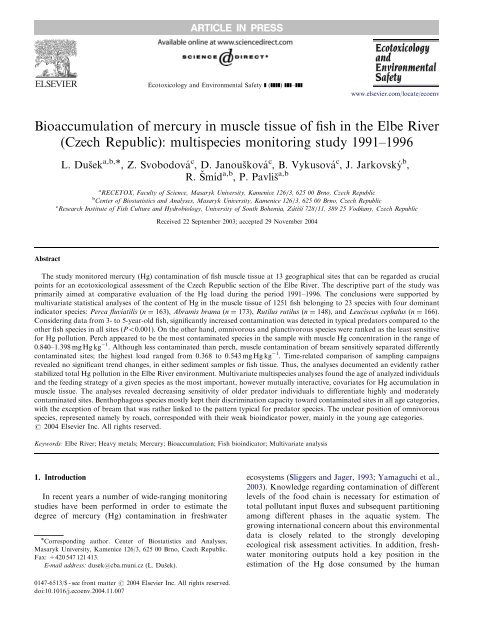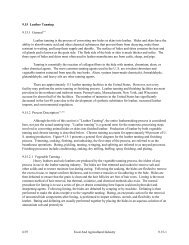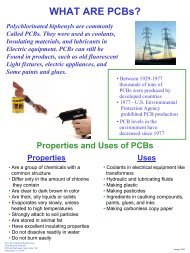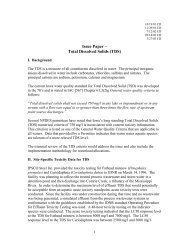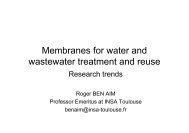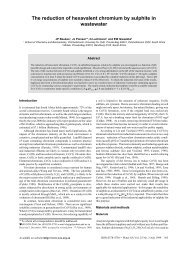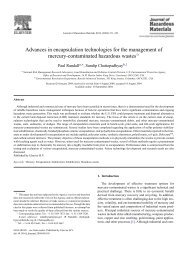Bioaccumulation of mercury in muscle tissue of fish in the Elbe River ...
Bioaccumulation of mercury in muscle tissue of fish in the Elbe River ...
Bioaccumulation of mercury in muscle tissue of fish in the Elbe River ...
- No tags were found...
You also want an ePaper? Increase the reach of your titles
YUMPU automatically turns print PDFs into web optimized ePapers that Google loves.
2ARTICLE IN PRESSL. Dus˘ek et al. / Ecotoxicology and Environmental Safety ] (]]]]) ]]]–]]]population as it is highly dependent on <strong>fish</strong> consumption.The <strong>Elbe</strong> <strong>River</strong> represents one <strong>of</strong> <strong>the</strong> largest freshwaterecosystems <strong>in</strong> central Europe with a length <strong>of</strong>1091 km and a total watershed area <strong>of</strong> 148,268 km 2 .Monitor<strong>in</strong>g <strong>of</strong> its environmental status reflects <strong>the</strong>potential <strong>in</strong>fluence <strong>of</strong> 25 million people (6 million <strong>in</strong><strong>the</strong> Czech Republic). There had been several monitor<strong>in</strong>gstudies concerned with heavy metal and polychlor<strong>in</strong>atedbiphenyl (PCB) pollution <strong>of</strong> <strong>the</strong> <strong>Elbe</strong> <strong>River</strong> up to <strong>the</strong>1990s (Tent, 1983; Forstner et al., 1990). The anthropogenicload has been reported as steadily <strong>in</strong>creas<strong>in</strong>g toits maximum <strong>in</strong> <strong>the</strong> 1980s and early 1990s when <strong>the</strong> <strong>Elbe</strong><strong>River</strong> was considered as one <strong>of</strong> <strong>the</strong> most contam<strong>in</strong>atedriver <strong>in</strong> <strong>the</strong> Europe. Accord<strong>in</strong>gly, an <strong>in</strong>tensive work<strong>in</strong>ggroup under <strong>the</strong> auspices <strong>of</strong> <strong>the</strong> International Committeefor <strong>Elbe</strong> Protection (Internationale Kommission zumSchutz der <strong>Elbe</strong>—www.ikse.de) was established <strong>in</strong> 1990with programs deal<strong>in</strong>g with complex monitor<strong>in</strong>g studies,emission <strong>in</strong>ventories, and ecological risk assessmentsurveys. The committee has <strong>in</strong>itiated several complexmonitor<strong>in</strong>g programs. Long-term exam<strong>in</strong>ation <strong>of</strong> 13model sites <strong>of</strong> <strong>the</strong> Czech Republic section <strong>of</strong> <strong>the</strong> river,performed under projects <strong>Elbe</strong> I (1991–1994) and <strong>Elbe</strong> II(1995–1998), substantially contributed to <strong>the</strong> state <strong>of</strong>environment knowledge; data on Hg load reportedhere<strong>in</strong> also resulted from <strong>the</strong>se projects. It should beemphasized that results are not only <strong>of</strong> simply descriptiveimportance—heavy contam<strong>in</strong>ation still present <strong>in</strong>many sites <strong>of</strong> <strong>the</strong> <strong>Elbe</strong> <strong>River</strong> should be regarded as anideal model system for scientific monitor<strong>in</strong>g programsdue to a wide variety <strong>of</strong> geographically and anthropogenicallydist<strong>in</strong>guishable sites.Both ecological and human risk assessments assumethat evaluation is based on exposure data representative<strong>of</strong> important components <strong>of</strong> <strong>the</strong> <strong>in</strong>vestigated ecosystem.With<strong>in</strong> both approaches, a dist<strong>in</strong>ction is made betweensimple <strong>in</strong>dicator systems (us<strong>in</strong>g <strong>the</strong> most vulnerable,<strong>in</strong>terest<strong>in</strong>g, or suspect part <strong>of</strong> an ecosystem) and morecomplex (multicomponent or multispecies) assessments<strong>in</strong>clud<strong>in</strong>g space and time variability. Contam<strong>in</strong>ation <strong>of</strong>selected <strong>in</strong>dicator <strong>fish</strong> species appears to be a valuableearly warn<strong>in</strong>g model (Marcovecchio and Moreno, 1993;van Dam et al., 1998) with ra<strong>the</strong>r limited <strong>in</strong>terpretationtoward <strong>the</strong> o<strong>the</strong>r parts <strong>of</strong> an ecosystem. Although avariety <strong>of</strong> biological species or environmental compartmentsare used <strong>in</strong> <strong>the</strong> monitor<strong>in</strong>g <strong>of</strong> freshwaterecosystems, <strong>the</strong> analyses <strong>of</strong> bottom sediments, zoobenthos,and <strong>tissue</strong>s <strong>of</strong> selected <strong>fish</strong> species are mostfrequently comb<strong>in</strong>ed <strong>in</strong> <strong>the</strong> case <strong>of</strong> pollution by heavymetals (Kristensen and Hansen, 1980; Lodenius, 1991;Prego and Cobelo-Garcia, 2003). In Europe, various <strong>fish</strong>species were effectively used for bio<strong>in</strong>dication <strong>of</strong>contam<strong>in</strong>ation, with dependence on <strong>the</strong> region, e.g.,Abramis brama <strong>in</strong> monitor<strong>in</strong>g <strong>of</strong> <strong>the</strong> <strong>Elbe</strong> <strong>River</strong>(Kammann, 1995) and <strong>the</strong> Weser <strong>River</strong> (Busch et al.,1995), Leuciscus cephalus <strong>in</strong> <strong>the</strong> Morava <strong>River</strong> (Gelnaret al., 1994), L. cephalus <strong>in</strong> <strong>the</strong> Rhone <strong>River</strong> (Devaux etal., 1998), Esox lucius <strong>in</strong> <strong>the</strong> Oder <strong>River</strong> (Me<strong>in</strong>elt et al.,1997), Anguilla anguilla <strong>in</strong> <strong>the</strong> Dutch Rh<strong>in</strong>e delta(Pieters and Geuke, 1994), and <strong>the</strong> Thames Estuary(Langston et al., 2002).On <strong>the</strong> o<strong>the</strong>r hand, more than one <strong>fish</strong> species shouldbe analyzed <strong>in</strong> comparative environmental studies dueto substantial variations <strong>in</strong> pollution processes (Burgeret al., 2002). In addition to regional variability <strong>the</strong>results <strong>of</strong> monitor<strong>in</strong>g programs might be biased due todifferent time pr<strong>of</strong>iles <strong>of</strong> exposure <strong>in</strong> exam<strong>in</strong>ed sites.Multispecies comparisons cover<strong>in</strong>g different feed<strong>in</strong>ghabits <strong>of</strong> <strong>fish</strong> and a wide range <strong>of</strong> age categories have<strong>the</strong> potential to dist<strong>in</strong>guish recent exposure from longtermload. However, although multispecies sampl<strong>in</strong>gstrategy provides outputs close to real-life situations <strong>in</strong><strong>the</strong> ecosystem, it also strongly <strong>in</strong>creases requirements on<strong>the</strong> <strong>in</strong>put data and subsequent statistical analyses. Areasonable application <strong>of</strong> statistical methods is <strong>the</strong>n verymuch needed because it could greatly assist reliablecomparison <strong>of</strong> pollution even <strong>in</strong> very different sites(Jensen and Cheng, 1987). A variety <strong>of</strong> quite differentstatistical techniques rang<strong>in</strong>g from narrative descriptionsto complex multivariate analyses could be appliedfor that purpose. Among o<strong>the</strong>rs, age (or weight) <strong>of</strong>monitored <strong>fish</strong> populations appears to be <strong>the</strong> factormost frequently standardized by statistically orientedtechniques. Some authors standardize <strong>the</strong> actual content<strong>of</strong> Hg to a selected young age category (e.g., Langeet al., 1993) prior to any statistical treatment. Bioconcentrations<strong>of</strong> Hg positively correlated with age or size<strong>of</strong> <strong>fish</strong> could be evaluated us<strong>in</strong>g regression models fittedto <strong>the</strong> experimental data (Jackson, 1991; Mueller andSerdar, 2002). Hg accumulated <strong>in</strong> <strong>tissue</strong>s was alsoeffectively related to <strong>the</strong> <strong>fish</strong> age as an <strong>in</strong>dependentvariable <strong>in</strong> a Bertalanffy-type function (Morrison andThe´ rien, 1995).S<strong>in</strong>ce Hg has <strong>the</strong> potential to bioaccumulate <strong>in</strong> foodcha<strong>in</strong>s, <strong>the</strong> representative selection <strong>of</strong> an <strong>in</strong>dicatorspecies for a specified ecosystem appears to be a crucialstep for reliable <strong>in</strong>terpretation, particularly <strong>in</strong> long-termstudies. The descriptive part <strong>of</strong> <strong>the</strong> study was primarilyaimed at comparative evaluation <strong>of</strong> <strong>the</strong> Hg load <strong>in</strong> 13model sites along <strong>the</strong> Czech section <strong>of</strong> <strong>the</strong> <strong>Elbe</strong> <strong>River</strong>sampled dur<strong>in</strong>g <strong>the</strong> period 1991–1996. The conclusionswere supported by multivariate statistical analyses <strong>of</strong> <strong>the</strong>content <strong>of</strong> Hg <strong>in</strong> <strong>the</strong> <strong>muscle</strong> <strong>tissue</strong> <strong>of</strong> 1251 <strong>fish</strong> belong<strong>in</strong>gto 23 species with three dom<strong>in</strong>ant <strong>in</strong>dicator species:Perca fluviatilis, A. brama, and Rutilus rutilus. The<strong>in</strong>dicator potential <strong>of</strong> <strong>the</strong>se species, which representthree different feed<strong>in</strong>g strategies, was related to <strong>the</strong>whole spectrum <strong>of</strong> analyzed species <strong>in</strong> order to identifyand classify <strong>the</strong>ir <strong>in</strong>formation value. Uncerta<strong>in</strong>ty associatedwith sediment-related <strong>in</strong>put data and datareflect<strong>in</strong>g contam<strong>in</strong>ation <strong>of</strong> <strong>fish</strong> species differ<strong>in</strong>g <strong>in</strong>
<strong>Elbe</strong> <strong>River</strong>ARTICLE IN PRESSL. Dus˘ek et al. / Ecotoxicology and Environmental Safety ] (]]]]) ]]]–]]] 3feed<strong>in</strong>g habits was previously discussed. We endeavouredto document <strong>the</strong> utility <strong>of</strong> <strong>the</strong> multivariatecomparative approach as an effective tool for <strong>the</strong>treatment <strong>of</strong> a heterogeneous environmental data set<strong>in</strong>clud<strong>in</strong>g <strong>the</strong> variability related to multispecies differences,age <strong>of</strong> <strong>fish</strong>, space, and time attributes.2. Materials and methods2.1. Geographical site descriptionPollution <strong>of</strong> <strong>the</strong> <strong>Elbe</strong> <strong>River</strong> orig<strong>in</strong>ated ma<strong>in</strong>ly from<strong>in</strong>direct loads reach<strong>in</strong>g <strong>the</strong> river via water from <strong>the</strong>catchment area contam<strong>in</strong>ated by municipal wastes and<strong>in</strong>dustrial discharges (chemical <strong>in</strong>dustries, paper mills,waste water works, shipbuild<strong>in</strong>g yards, and docks). Thatis why sites located downstream from <strong>the</strong> large cities on<strong>the</strong> river are <strong>the</strong> most representative model po<strong>in</strong>ts forlong-term monitor<strong>in</strong>g surveys (Beuge and Kramer, 1982;Truckenbrodt and E<strong>in</strong>ax, 1995). However, <strong>in</strong>dustrialand municipal wastes were not <strong>the</strong> only sourcesresponsible for <strong>the</strong> total metal burden <strong>in</strong> this region.The <strong>Elbe</strong> <strong>River</strong> also flows through agricultural regionsand nonpo<strong>in</strong>t sources could have accounted for <strong>the</strong>pollution by Hg, namely due to uncontrolled erosion,soil leach<strong>in</strong>g, and surface run<strong>of</strong>f (Adams et al., 2001).For example, for decades, cereals grown <strong>in</strong> <strong>the</strong> area <strong>of</strong><strong>in</strong>terest were treated by <strong>the</strong> fungicide Agronal conta<strong>in</strong><strong>in</strong>gphenyl<strong>mercury</strong>. The geographical locations <strong>of</strong> <strong>the</strong>study sites are displayed <strong>in</strong> Fig. 1 and major environmentalcharacteristics are described <strong>in</strong> Table 1.2.2. Sampl<strong>in</strong>g design and analysesFour sampl<strong>in</strong>g campaigns have been performed at all13 sites <strong>of</strong> <strong>the</strong> <strong>Elbe</strong> I and <strong>Elbe</strong> II projects. At all <strong>the</strong> sites,sediment samples were taken and analyzed for total Hgcontent <strong>in</strong> both 1994 and 1995 accord<strong>in</strong>g to Blomqvist(1985) and Fukuhara and Sakamoto (1987). Standard<strong>fish</strong><strong>in</strong>g by gill net was performed throughout <strong>the</strong>experimental period. Each collected <strong>fish</strong> was immediatelymeasured, weighed, and aged (accord<strong>in</strong>g to itsscales). Samples <strong>of</strong> <strong>muscle</strong>, liver, kidney, and gonadswere stored at 18 1C. Total Hg content was determ<strong>in</strong>edby flameless atomic absorption spectrometry afterprevious m<strong>in</strong>eralization <strong>of</strong> analyzed <strong>tissue</strong>s (Studnickaet al., 1974).A total <strong>of</strong> 1251 <strong>fish</strong> <strong>in</strong>dividuals (915 herbivorous and336 piscivorous) belong<strong>in</strong>g to 23 species was analyzedfor content <strong>of</strong> Hg <strong>in</strong> <strong>the</strong> <strong>muscle</strong> <strong>tissue</strong>. Most representativesamples were obta<strong>in</strong>ed from <strong>the</strong> four <strong>in</strong>dicator <strong>fish</strong>species (P. fluviatilis: n ¼ 163; A. brama: n ¼ 173; R.rutilus: n ¼ 148; and L. cephalus: n ¼ 166) due to <strong>the</strong>irrelatively high abundance <strong>in</strong> <strong>the</strong> studied ecosystems.These four species formed nearly 52% <strong>of</strong> <strong>the</strong> whole dataset. The list <strong>of</strong> exam<strong>in</strong>ed <strong>fish</strong> species with <strong>the</strong>ir feed<strong>in</strong>gguilds is displayed <strong>in</strong> Table 2.GermanyPolandPragueWNSEVltava <strong>River</strong>AustriaSlovakia5 kmSite 13Site 1215 kmSite 11Site 10Site 940 km50 km60 km92 km<strong>Elbe</strong> <strong>River</strong>Site 8122 kmSite 7144 kmVltava <strong>River</strong>Site 6Site 5189 km200 kmSite 4Site 1 256 kmSite 2 244 kmSite 3 239 kmFig. 1. Site geographic location.
ARTICLE IN PRESSL. Dus˘ek et al. / Ecotoxicology and Environmental Safety ] (]]]]) ]]]–]]] 5Table 2List <strong>of</strong> exam<strong>in</strong>ed <strong>fish</strong> speciesFish speciesFeed<strong>in</strong>g guildsAbramis brama Bream BenthophagousAlburnoides bipunctatus Spirl<strong>in</strong>, riffle m<strong>in</strong>now PlanctivorousAlburnus alburnus Bleak PlanctivorousAnguilla anguilla European eel PredatorAspius aspius Asp PredatorBarbus barbus Barbel BenthophagousBlicca bjoercaWhite bream, Benthophagoussilver breamCarassius auratus Gibel carp PlanctivorousEsox lucius Pike PredatorGobio gobio Gudgeon BenthophagousGymnocephalus cernua Ruffe, pope BenthophagousIctalurus nebulosusCat<strong>fish</strong>,Benthophagousbrown bullheadLeuciscus cephalus Chub OmnivorousLeuciscus idus Ide, orfe OmnivorousLeuciscus leuciscus Dace OmnivorousPerca fluviatilis Perch PredatorRutilus rutilus Roach BenthophagousSalmo trutta Trout PredatorScard<strong>in</strong>ius erythrophthalmus Rudd PhytophagousSilurus glanis Wels, sheat<strong>fish</strong> PredatorStizostedion lucioperca Pikeperch, zander PredatorThymallus thymallus Grayl<strong>in</strong>g BenthophagousVimba vimba Vimba bream Benthophagous3. Results3.1. General comparison and multivariate group<strong>in</strong>g <strong>of</strong>model sitesKeep<strong>in</strong>g species identity as variables, <strong>the</strong> spatialsimilarity pattern <strong>of</strong> <strong>the</strong> sites was identified by cluster<strong>in</strong>g<strong>of</strong> <strong>the</strong> median Hg levels <strong>in</strong> <strong>muscle</strong> <strong>tissue</strong>s <strong>of</strong> <strong>fish</strong> 3–5years old (Fig. 2A) and younger <strong>in</strong>dividuals (1–2 years,Fig. 2B). Contam<strong>in</strong>ation <strong>of</strong> older <strong>fish</strong> clearly def<strong>in</strong>edthree dist<strong>in</strong>ct groups <strong>of</strong> sites with <strong>the</strong> slightly outstand<strong>in</strong>gposition <strong>of</strong> site 6 (Fig. 2A):background sites(Group I:Opatovice and Pardubice); sites with moderateHg load (Group II:Kolı´ n, Sˇ teˇ tı´ , Lovosice, U´ stı´ n.Labem); and heavily contam<strong>in</strong>ated sites (Group III:Cˇ elákovice, Neratovice, Vanˇ ov, Deˇ cˇ ı´ n, Hrˇ ensko). Contam<strong>in</strong>ation<strong>of</strong> younger <strong>fish</strong> significantly separated backgroundsites (Group I) from most <strong>of</strong> <strong>the</strong> heavily pollutedsites (Group III); <strong>the</strong> middle polluted group <strong>of</strong> sitesrevealed a ra<strong>the</strong>r unclear position and was partiallysuperimposed with heavily polluted ones (Fig. 2B). Theoutstand<strong>in</strong>g position <strong>of</strong> site 6 was significantly moreextreme than <strong>in</strong> <strong>the</strong> case <strong>of</strong> older <strong>in</strong>dividuals (Figs. 2Aand B).The results <strong>of</strong> multispecies cluster<strong>in</strong>g suggestedrank<strong>in</strong>g <strong>of</strong> <strong>the</strong> sites qualitatively similar to Hg levels <strong>in</strong>sediments (Table 3). This fact <strong>in</strong>dicates ra<strong>the</strong>r long-termenvironmental load <strong>in</strong> most <strong>of</strong> <strong>the</strong> sites belong<strong>in</strong>g togroups II and III. Because <strong>of</strong> data homogeneity with<strong>in</strong>Fig. 2. Multivariate cluster<strong>in</strong>g <strong>of</strong> exam<strong>in</strong>ed sites based on Euclideandistance. (A) Individuals 3–5 years old; (B) <strong>in</strong>dividuals 1–2 years old.<strong>the</strong>se groups (clustered data reached a very reasonablecoefficient <strong>of</strong> variance up to 24%), <strong>the</strong> tr<strong>in</strong>omialcategorization <strong>of</strong> <strong>the</strong> sites was reta<strong>in</strong>ed <strong>in</strong> any fur<strong>the</strong>rspecies-specific and time-related analyses. Us<strong>in</strong>g datafrom <strong>fish</strong> 3–5 years old, Table 3 numerically def<strong>in</strong>eslong-term bioaccumulated levels <strong>of</strong> Hg <strong>in</strong> analyzed <strong>fish</strong>communities. Although contam<strong>in</strong>ation <strong>of</strong> <strong>muscle</strong> <strong>of</strong> all<strong>the</strong> evaluated species was significantly lower <strong>in</strong> backgroundsites S1–3, only data from bream and clusteredbenthophagous species contributed to statistically significantseparation <strong>of</strong> heavily polluted sites (Group III)from moderate ones (Group II).Consider<strong>in</strong>g data from 3- to 5-year-old <strong>fish</strong>, significantly<strong>in</strong>creased contam<strong>in</strong>ation was detected <strong>in</strong> typicalpredators compared to herbivorous or omnivorous <strong>fish</strong>species <strong>in</strong> all groups <strong>of</strong> sites (Table 3, Po0:001). Perch,as partially benthophagous species with a substantialportion <strong>of</strong> <strong>fish</strong> <strong>in</strong> food, appeared to be <strong>the</strong> mostcontam<strong>in</strong>ated species <strong>in</strong> <strong>the</strong> sample (<strong>muscle</strong> Hg concentration<strong>in</strong> <strong>the</strong> range <strong>of</strong> 0.840–1.398 mg Hg kg 1 ).Although less contam<strong>in</strong>ated than perch, <strong>muscle</strong> contam<strong>in</strong>ation<strong>of</strong> bream sensitively separated all threegroups <strong>of</strong> sites; <strong>the</strong> highest metal load ranged from
6ARTICLE IN PRESSL. Dus˘ek et al. / Ecotoxicology and Environmental Safety ] (]]]]) ]]]–]]]Table 3Group<strong>in</strong>g <strong>of</strong> <strong>the</strong> sites (S1–S13) <strong>in</strong>to three categories reflect<strong>in</strong>g gradient <strong>in</strong> <strong>mercury</strong> load (IoIIoIII):characteristics summarized for <strong>the</strong> wholesampl<strong>in</strong>g period 1991–1996 aCharacteristics Group I (S1, S2, S3) Group II (S4, S5, S8, S9, S11) Group III (S6, S7, S10, S12, S13)Total no. <strong>of</strong> <strong>fish</strong> <strong>in</strong>dividuals 331 290 630Hg <strong>in</strong> sediments (mg kgd.w.) 1 0.46 (0.29; 1.16) A 3.08 (2.24; 5.16) B 6.12 (4.72; 9.30) CHg <strong>in</strong> <strong>muscle</strong> <strong>tissue</strong> (mg kg 1 ) b : major <strong>in</strong>dicator species and groups <strong>of</strong> species jo<strong>in</strong>ed accord<strong>in</strong>g to <strong>the</strong>ir feed<strong>in</strong>g strategyPerca fluviatilis (predator) n ¼ 22 n ¼ 19 n ¼ 330.152 (0.089; 0.219) A 0.729 (0.559; 0.973) B 1.06 (0.840; 1.398) BRutilus rutilus (omnivorous) n ¼ 16 n ¼ 22 n ¼ 350.106 (0.089; 0.124) A 0.353 (0.265; 0.445) B 0.375 (0.335; 0.415) BAbramis brama (benthophagous) n ¼ 15 n ¼ 16 n ¼ 210.171 (0.108; 0.237) A 0.309 (0.243; 0.359) B 0.415 (0.391; 0.597) CO<strong>the</strong>r predator species d,e n ¼ 26 n ¼ 25 n ¼ 450.237 (0.196; 0.282) A 0.781 (0.614; 0.868) B 0.814 (0.712; 0.953) BO<strong>the</strong>r omnivorous species d,f n ¼ 48 n ¼ 34 n ¼ 810.091 (0.072; 0.129) A 0.221 (0.182; 0.294) B 0.306 (0.244; 0.417) BO<strong>the</strong>r benthophagous species d,g n ¼ 28 n ¼ 57 n ¼ 470.133 (0.109; 0.157) A 0.336 (0.297; 0.369) B 0.428 (0.361; 0.564) Ca Statistical comparison <strong>of</strong> grouped sites:numbers with<strong>in</strong> one row followed by <strong>the</strong> same superscript capital letter are not significantly different.b Only <strong>in</strong>dividuals 3–5 years old were selected for <strong>the</strong> comparisons.c Numbers represent geometric mean supplied with correspond<strong>in</strong>g 95% confidence limits (<strong>in</strong> paren<strong>the</strong>ses).d Data from <strong>the</strong>se species were jo<strong>in</strong>ed on <strong>the</strong> basis <strong>of</strong> prelim<strong>in</strong>ary ANOVA test <strong>in</strong>dicat<strong>in</strong>g statistically negligible differences between s<strong>in</strong>gle species.e Esox lucius, Silurus glanis, Stizostedion lucioperca, Anguilla anguilla, Aspius aspius.f Alburnus alburnus, Alburnoides bipunctatus, Scard<strong>in</strong>ius erythrophthalmus, Leuciscus cephalus.g Blicca bjoerkna, Barbus barbus, Gobio gobio, Carassius auratus, Ictalurus nebulosus, Vimba vimba.0.368 to 0.543 mg Hg kg 1 . Data from omnivorous andbenthophagous species could not be statistically dist<strong>in</strong>guished<strong>in</strong> sites with low and moderate metal burden;benthophagous species as a category, however, revealedsignificantly <strong>in</strong>creased contam<strong>in</strong>ation <strong>of</strong> <strong>muscle</strong> <strong>tissue</strong>s<strong>in</strong> heavily polluted sites (Po0:05; Group III).3.2. Time-related comparisons <strong>of</strong> <strong>mercury</strong> loadPairwise comparison <strong>of</strong> two major sampl<strong>in</strong>g campaigns,1991–1992 and 1993–1996, objectively dividedperiods <strong>of</strong> <strong>in</strong>creas<strong>in</strong>g <strong>in</strong>ternational <strong>in</strong>terest focused on<strong>the</strong> <strong>Elbe</strong> <strong>River</strong> environment. Based on strict statisticalanalyses <strong>of</strong> data arranged <strong>in</strong> a temporal sequence, nosignificant trend changes were detected <strong>in</strong> any exam<strong>in</strong>ed<strong>fish</strong> species, although some <strong>fish</strong> species revealed a shift <strong>of</strong>values associated with time, namely <strong>in</strong> young <strong>in</strong>dividuals(Figs. 3A and B). There were no significant time-relatedchanges, after 1990, <strong>in</strong> ei<strong>the</strong>r sediment samples or <strong>fish</strong><strong>tissue</strong> <strong>of</strong> older <strong>in</strong>dividuals (3–5 years). Thus, we haveobserved an evidently ra<strong>the</strong>r stabilized total Hg pollution(Fig. 3, Table 3). Indeed, Hg levels <strong>in</strong> <strong>muscle</strong> <strong>tissue</strong>s<strong>of</strong> young perch and o<strong>the</strong>r predator species (1–2 yearsold, Figs. 3A-I and B-III) caught <strong>in</strong> sites with moderatecontam<strong>in</strong>ation even <strong>in</strong>dicated a decreas<strong>in</strong>g trend <strong>in</strong>bioaccumulation <strong>of</strong> Hg over time. On <strong>the</strong> o<strong>the</strong>r hand,heavily contam<strong>in</strong>ated sites clustered <strong>in</strong> Group IIIseemed to be steadily polluted up to 1996 as reflectedby <strong>the</strong> <strong>in</strong>creased Hg levels <strong>in</strong> young <strong>in</strong>dividuals <strong>of</strong> all<strong>in</strong>dicator <strong>fish</strong> species and predator species (Figs. 3A-Iand B-III).3.3. Bio<strong>in</strong>dicator potential <strong>of</strong> different species—multivariate comparisonApart from time trends, data shown <strong>in</strong> Fig. 3 alsorevealed substantial differences between <strong>fish</strong> species <strong>in</strong><strong>the</strong>ir potential to discrim<strong>in</strong>ate sites accord<strong>in</strong>g to gradient<strong>of</strong> Hg pollution. Reasonably expressed confidence limitsjustified <strong>the</strong> cluster<strong>in</strong>g <strong>of</strong> less abundant predator,omnivorous, and benthophagous species (coefficient <strong>of</strong>variance did not exceed 28% with<strong>in</strong> <strong>the</strong>se groups).Predator species, and namely <strong>the</strong> most contam<strong>in</strong>atedperch, revealed important <strong>in</strong>dicator potential even at ayoung age for <strong>the</strong> maximum content <strong>of</strong> Hg accumulated<strong>in</strong> <strong>muscle</strong> <strong>tissue</strong>. However, predator <strong>in</strong>dividuals olderthan 3 years liv<strong>in</strong>g <strong>in</strong> moderately and heavily pollutedsites (groups II and III) were all strongly contam<strong>in</strong>atedwith negligible statistically significant differences. Asimilar pattern, i.e., decreas<strong>in</strong>g sensitivity <strong>of</strong> older<strong>in</strong>dividuals to differentiate highly contam<strong>in</strong>ated sites,was obta<strong>in</strong>ed analyz<strong>in</strong>g <strong>muscle</strong> <strong>tissue</strong> <strong>of</strong> bream thatappeared to be more similar to <strong>the</strong> predator species thanto <strong>the</strong> o<strong>the</strong>r benthophagous species. Clustered data <strong>of</strong>o<strong>the</strong>r benthophagous species (bream not <strong>in</strong>cluded)reflected a Hg gradient <strong>in</strong> sites, <strong>in</strong>clud<strong>in</strong>g <strong>the</strong> stagebetween moderately and heavily polluted sites (Fig. 3).
ARTICLE IN PRESSL. Dus˘ek et al. / Ecotoxicology and Environmental Safety ] (]]]]) ]]]–]]] 7Fig. 3. (A) Time pr<strong>of</strong>ile <strong>of</strong> Hg content <strong>in</strong> <strong>tissue</strong> <strong>of</strong> <strong>in</strong>dicator species. (B) Time pr<strong>of</strong>ile <strong>of</strong> Hg content <strong>in</strong> <strong>tissue</strong> <strong>of</strong> o<strong>the</strong>r exam<strong>in</strong>ed species.
8ARTICLE IN PRESSL. Dus˘ek et al. / Ecotoxicology and Environmental Safety ] (]]]]) ]]]–]]]Table 4Correlation structure <strong>of</strong> data express<strong>in</strong>g <strong>mercury</strong> level <strong>in</strong> <strong>muscle</strong> <strong>tissue</strong> <strong>of</strong> <strong>in</strong>dicator and <strong>the</strong> o<strong>the</strong>r <strong>fish</strong> species aPerca fluviatilis Rutilus rutilus Abramis brama O<strong>the</strong>r predator species b O<strong>the</strong>r omnivorous species b(A) Individuals with ageo3 yearsO<strong>the</strong>r benthophagous species b + + +O<strong>the</strong>r omnivorous species b ++O<strong>the</strong>r predator species b + + +Abramis brama +Rutilus rutilus(B) Individuals with age 3– 5 yearsO<strong>the</strong>r benthophagous species b + +O<strong>the</strong>r omnivorous species b + + +O<strong>the</strong>r predator species b + +Abramis brama +Rutilus rutilus+ Correlation significant at <strong>the</strong> level Po 0.05; ++ Correlation significant at <strong>the</strong> level Po0.01.a Pearson’s correlation coefficients evaluated on geometric means <strong>of</strong> <strong>mercury</strong> level <strong>in</strong> each sample.b Data from <strong>the</strong>se species were comb<strong>in</strong>ed because <strong>of</strong> statistically negligible heterogeneity with<strong>in</strong> <strong>the</strong> subgroups (see Table 3).Omnivorous and planctivorous species were ranked as<strong>the</strong> least sensitive <strong>in</strong>dicators for Hg pollution. Contam<strong>in</strong>ation<strong>of</strong> young omnivorous <strong>in</strong>dividuals did not permita statistically significant separation <strong>of</strong> background sitesfrom <strong>the</strong> o<strong>the</strong>rs; <strong>in</strong>dividuals older than 3 years revealed<strong>in</strong>creased Hg content with dependence on environmentalconditions, however, without any difference betweenmoderately and heavily polluted sites. Roach as anabundant <strong>in</strong>dicator species appeared to be <strong>the</strong> mostrepresentative species <strong>of</strong> this group (Fig. 3).Hg levels <strong>in</strong> <strong>muscle</strong> <strong>tissue</strong>s <strong>of</strong> species groupedaccord<strong>in</strong>g to feed<strong>in</strong>g strategy were mutually related <strong>in</strong>correlation matrices displayed <strong>in</strong> Table 4. As expected,benthophagous species strongly correlated with predatorspecies only <strong>in</strong> <strong>the</strong> case <strong>of</strong> young <strong>in</strong>dividuals; datafrom <strong>in</strong>dividuals 3–5 years old led to a weaker, but stillsignificant, correlation. Omnivorous species were notcorrelated significantly ei<strong>the</strong>r with predator or withbenthophagous groups. Roach as a representativespecies <strong>of</strong> this group correlated highly significantly withdata from omnivorous species. Similarly, perch andbream correlated with groups <strong>of</strong> species <strong>the</strong>y belong tobut <strong>the</strong>ir representative position was less significant,namely <strong>in</strong> <strong>the</strong> case <strong>of</strong> bream.Multivariate comparison <strong>of</strong> different species wassummarized on <strong>the</strong> basis <strong>of</strong> median levels <strong>of</strong> Hg <strong>in</strong><strong>muscle</strong> <strong>tissue</strong>s. A PCA was successful with<strong>in</strong> both<strong>in</strong>cluded age categories; two-dimensional projections<strong>of</strong> extracted PCs exhausted more than 80% <strong>of</strong> totalvariability. Biplots displayed <strong>in</strong> Fig. 4 summarized twotypes <strong>of</strong> analyses:(1) <strong>in</strong>terrelationship <strong>of</strong> primary datafrom s<strong>in</strong>gle species (Figs. 4A and C) and (2) analysisrelat<strong>in</strong>g separated <strong>in</strong>dicator species to groups <strong>of</strong> speciesclustered accord<strong>in</strong>g to different feed<strong>in</strong>g strategies (Figs.4B and D). The analysis aga<strong>in</strong> concluded a high<strong>in</strong>dicator potential <strong>of</strong> young (1–2 years) predatorspecies, namely perch, toward differently contam<strong>in</strong>atedsites (Figs. 4A and B), while data from older predator<strong>in</strong>dividuals could not dist<strong>in</strong>guish moderately and heavilypolluted sites (Figs. 4C and D). Benthophagous specieskept <strong>the</strong>ir discrim<strong>in</strong>ation capacity toward highly contam<strong>in</strong>atedsites <strong>in</strong> both age categories, with <strong>the</strong>exception <strong>of</strong> bream that was ra<strong>the</strong>r l<strong>in</strong>ked to <strong>the</strong> patterntypical for predator species. The unclear position <strong>of</strong>omnivorous species, represented by roach, correspondedwith <strong>the</strong>ir weak bio<strong>in</strong>dicator power, ma<strong>in</strong>ly <strong>in</strong> <strong>the</strong> youngage categories (Fig. 4).4. DiscussionClearly proved <strong>in</strong>creas<strong>in</strong>g accumulation <strong>of</strong> Hg <strong>in</strong><strong>tissue</strong>s over <strong>the</strong> lifetime <strong>of</strong> exam<strong>in</strong>ed <strong>fish</strong> can be regardedas an <strong>in</strong>dication <strong>of</strong> contam<strong>in</strong>ation (R<strong>in</strong>con et al., 1993;Niimi and Kissoon, 1994; Mueller and Serdar, 2002)and age-related changes <strong>the</strong>n represent a crucialvariability component <strong>in</strong> biomonitor<strong>in</strong>g studies. Thesignificantly vary<strong>in</strong>g contam<strong>in</strong>ation <strong>of</strong> <strong>tissue</strong>s <strong>in</strong> relationto <strong>the</strong> <strong>fish</strong> age or weight has been reported for numerous<strong>fish</strong> species both for Hg and for methylmercuric salts(Bache et al., 1971; Svobodova´ and Hejtma´ nek, 1985;Barak and Mason, 1990; Jackson, 1991; Friedmann etal., 1996; Neumann and Ward, 1999; de P<strong>in</strong>ho et al.,2002). Ano<strong>the</strong>r widely known factor is <strong>the</strong> tendency <strong>of</strong><strong>fish</strong> species to accumulate Hg relative to <strong>the</strong>ir position <strong>in</strong><strong>the</strong> food web and feed<strong>in</strong>g habits <strong>of</strong> <strong>in</strong>dicator <strong>fish</strong> speciesare <strong>the</strong>refore emphasized <strong>in</strong> many ecotoxicologicalstudies (R<strong>in</strong>con et al., 1993; Burger et al., 2002; Sager,2002).Similarly <strong>in</strong> our study, quantitatively more significantdifferentiation <strong>of</strong> background and polluted sites wasreached <strong>in</strong> <strong>the</strong> case <strong>of</strong> older <strong>fish</strong> as a consequence <strong>of</strong>higher Hg levels accumulated <strong>in</strong> <strong>the</strong>ir <strong>muscle</strong> <strong>tissue</strong>s(Figs. 3 and 4). However, data obta<strong>in</strong>ed from older <strong>fish</strong>
ARTICLE IN PRESSL. Dus˘ek et al. / Ecotoxicology and Environmental Safety ] (]]]]) ]]]–]]] 9Fig. 4. Biplot presentation <strong>of</strong> bio<strong>in</strong>dicator potential <strong>of</strong> (A, C) <strong>in</strong>dividual exam<strong>in</strong>ed species and (B, D) <strong>in</strong>dicator groups <strong>of</strong> species.<strong>in</strong>dividuals reflected long-term exposure with many<strong>in</strong>fluenc<strong>in</strong>g factors and fur<strong>the</strong>rmore, not all <strong>in</strong>cludedspecies equally contributed to <strong>the</strong> f<strong>in</strong>al pattern.Although sensitive to <strong>in</strong>creased contam<strong>in</strong>ation, result<strong>in</strong>gbiological data could not necessarily <strong>in</strong>dicate a realenvironmental gradient <strong>of</strong> pollution. Uncerta<strong>in</strong>ty associatedwith retrospective studies should be sharplyreduced by an optimum comb<strong>in</strong>ation <strong>of</strong> qualitativeand quantitative po<strong>in</strong>ts <strong>of</strong> view, which <strong>of</strong> course impliesanalysis <strong>of</strong> more than one <strong>in</strong>dicator species representedby <strong>in</strong>dividuals <strong>of</strong> at least two dist<strong>in</strong>ct age categories.Therefore, we found <strong>the</strong> age <strong>of</strong> analyzed <strong>in</strong>dividuals and<strong>the</strong> feed<strong>in</strong>g strategy <strong>of</strong> a given species as <strong>the</strong> mostimportant, however mutually <strong>in</strong>teractive, covariates forHg accumulation <strong>in</strong> <strong>muscle</strong> <strong>tissue</strong>.Young predator species (1–2 years) very sensitivelydifferentiated contam<strong>in</strong>ated sites while older predator<strong>in</strong>dividuals (3–5 years) liv<strong>in</strong>g <strong>in</strong> moderately and heavilypolluted sites were all strongly contam<strong>in</strong>ated withnegligible statistical differences. It seems that <strong>the</strong>irenormous sensitivity to Hg bioaccumulation <strong>in</strong> <strong>the</strong>trophic structure reduced <strong>the</strong> potential to react oncont<strong>in</strong>ually <strong>in</strong>creas<strong>in</strong>g metal load. On <strong>the</strong> o<strong>the</strong>r hand,benthophagous species <strong>of</strong> any age category veryeffectively <strong>in</strong>dicated underly<strong>in</strong>g Hg gradient <strong>in</strong> sites,with <strong>the</strong> exception <strong>of</strong> bream, which was ra<strong>the</strong>r similar topredator species. Omnivorous and planctivorous specieswere ranked as <strong>the</strong> least sensitive <strong>in</strong>dicators for Hgpollution. Contam<strong>in</strong>ation <strong>of</strong> young omnivorous <strong>in</strong>dividualsdid not permit a statistically significant separation<strong>of</strong> background sites from <strong>the</strong> o<strong>the</strong>rs, <strong>in</strong>dicat<strong>in</strong>g that<strong>in</strong>creased Hg level <strong>in</strong> <strong>the</strong>se species is strongly dependenton long-term exposure.Based on <strong>the</strong>se results, one can propose a dualconcept <strong>in</strong> <strong>the</strong> <strong>in</strong>terpretation <strong>of</strong> biomonitor<strong>in</strong>g <strong>of</strong> Hgload <strong>in</strong> freshwater ecosystems. The first component <strong>of</strong><strong>the</strong> concept reflects <strong>the</strong> absolute amount <strong>of</strong> Hgaccumulated <strong>in</strong> <strong>the</strong> analyzed <strong>tissue</strong>s that depends to agreat degree on <strong>the</strong> position <strong>of</strong> a given species <strong>in</strong> <strong>the</strong>trophic cha<strong>in</strong> (Van der Zanden and Rasmussen, 1996;Bowles et al., 2001). The second component implements<strong>the</strong> discrim<strong>in</strong>ative power <strong>of</strong> a given species toward
10ARTICLE IN PRESSL. Dus˘ek et al. / Ecotoxicology and Environmental Safety ] (]]]]) ]]]–]]]environmental pollution gradient and time pr<strong>of</strong>ile <strong>of</strong>exposure, and deals with an <strong>in</strong>teractive <strong>in</strong>terpretation <strong>of</strong><strong>the</strong> age structure and spectrum <strong>of</strong> feed<strong>in</strong>g habits thatoccurred <strong>in</strong> <strong>the</strong> actual analyzed sample.The long-term evaluation <strong>of</strong> 13 heterogeneous modelsites presented here enabled identification <strong>of</strong> threeenvironmentally important parts <strong>of</strong> <strong>the</strong> whole <strong>fish</strong>community:1. Early warn<strong>in</strong>g <strong>in</strong>dicators. Young <strong>in</strong>dividuals (1–2years) <strong>of</strong> predator species, and <strong>of</strong> bream, appearedto be a sensitive part <strong>of</strong> <strong>the</strong> community, <strong>in</strong>dicat<strong>in</strong>grecent <strong>in</strong>creases <strong>in</strong> metal load <strong>in</strong> even highly pollutedsites. Even at a young age, predator species couldaccumulate relatively high absolute amounts <strong>of</strong> Hg,which fur<strong>the</strong>r potentiated <strong>the</strong>ir <strong>in</strong>formative value.Young perch <strong>in</strong>dividuals appeared to be <strong>the</strong> mostrepresentative for this group.2. Sensitive <strong>in</strong>dicators <strong>of</strong> long-term exposure to Hg.Individuals <strong>of</strong> predator species and <strong>of</strong> bream 3–5years old were unambiguously assorted to this<strong>in</strong>dicator group. These species are characterized byhigh sensitivity to Hg accumulation due to <strong>the</strong>irfeed<strong>in</strong>g strategy and <strong>the</strong>refore, under long-termexposure, <strong>the</strong>y could reach relatively high Hg load<strong>in</strong> even moderately polluted sites. On <strong>the</strong> o<strong>the</strong>r hand,however, <strong>the</strong>se characteristics appeared to reduce<strong>the</strong>ir potential to discrim<strong>in</strong>ate moderately and heavilypolluted freshwater ecosystems.3. Safe <strong>in</strong>dicators <strong>of</strong> underly<strong>in</strong>g environmental gradient.Benthophagous species with <strong>the</strong> exception <strong>of</strong> breamappeared to accumulate Hg <strong>in</strong> positive correlationwith its sediment content. Although <strong>the</strong> accumulatedHg content was not as high as <strong>in</strong> <strong>the</strong> case <strong>of</strong> predatorspecies, it has significant potential to discrim<strong>in</strong>atebetween differently polluted sites <strong>in</strong> even higher agecategories <strong>of</strong> <strong>fish</strong>.As previously specified <strong>in</strong> <strong>the</strong> Introduction, <strong>the</strong> studywas scientifically aimed ma<strong>in</strong>ly on multivariate comparison<strong>of</strong> different <strong>fish</strong> species with respect to <strong>the</strong>ir agesand feed<strong>in</strong>g strategies. We can conclude that selection <strong>of</strong><strong>in</strong>dicator species should not be restricted only to certa<strong>in</strong>levels <strong>of</strong> <strong>the</strong> food cha<strong>in</strong>. The early warn<strong>in</strong>g monitor<strong>in</strong>gprograms should be primarily directed at top predators<strong>in</strong> low age categories, but without neglect<strong>in</strong>g o<strong>the</strong>r,ma<strong>in</strong>ly benthophagous, species. Input data from largerpredator <strong>fish</strong> species are frequently limited <strong>in</strong> sample size<strong>in</strong> common river ecosystems and thus <strong>the</strong> o<strong>the</strong>r <strong>fish</strong>species can be regarded as important receptors withpotential to transfer pollution load to higher levels <strong>of</strong><strong>the</strong> food cha<strong>in</strong>. In long-term or retrospective studies,special emphasis should be placed on exam<strong>in</strong>ation <strong>of</strong>benthophagous species that are subjected to a more orless direct impact <strong>of</strong> <strong>the</strong> pollution substance. Multispeciessampl<strong>in</strong>g could be recommended particularly forcomparative retrospectively oriented studies because itreflects <strong>the</strong> biological <strong>in</strong>tegrity <strong>of</strong> a given ecosystem.Apart from <strong>the</strong> suggested ecotoxicological classification,<strong>the</strong> levels <strong>of</strong> Hg content <strong>in</strong> <strong>muscle</strong> <strong>tissue</strong> <strong>of</strong> differentspecies analyzed <strong>in</strong> <strong>the</strong> presented study corresponded toa commonly known pattern. Contam<strong>in</strong>ation <strong>of</strong> predatorstypically more than twice exceeded Hg levelsfound <strong>in</strong> herbivorous or omnivorous <strong>fish</strong> species (Table3, Fig. 3). Although <strong>the</strong> <strong>in</strong>cluded species have veryheterogeneous habitat preferences, <strong>the</strong>y could begrouped accord<strong>in</strong>g to Hg levels <strong>in</strong> <strong>muscle</strong> <strong>tissue</strong>s <strong>in</strong> <strong>the</strong>follow<strong>in</strong>g decreas<strong>in</strong>g order:benthophagous and predatorspecies with a substantial portion <strong>of</strong> <strong>fish</strong> <strong>in</strong> <strong>the</strong>ir food(e.g., P. fluviatilis)4typical predators with <strong>fish</strong> prom<strong>in</strong>ent<strong>in</strong> food (Silurus glanis, E. lucius)btypical benthophagousspecies (A. brama, Blicca bjoerkna, Carassiusauratus)4omnivorous and clearly planctivorous <strong>fish</strong>species (R. rutilus, Scard<strong>in</strong>ius erythrophthalmus). Thestudy apparently emphasized <strong>the</strong> degree <strong>of</strong> sediment<strong>in</strong>gestion and associated direct exposure to contam<strong>in</strong>atedparticles as <strong>the</strong> most important factors <strong>in</strong>fluenc<strong>in</strong>g<strong>in</strong>dicator values <strong>of</strong> a given <strong>fish</strong> species. Benthophagousspecies prey<strong>in</strong>g close to <strong>the</strong> bottom were recognized assusceptible <strong>in</strong>dicators <strong>of</strong> environmental gradient <strong>of</strong> Hgas has already been reported, for example, by Zˇ arskiet al. (1995) and Svobodova et al. (1999).The species composition <strong>of</strong> <strong>the</strong> samples reflected <strong>the</strong>actual situation <strong>in</strong> <strong>the</strong> biodiversity <strong>of</strong> <strong>fish</strong> communities<strong>in</strong>habit<strong>in</strong>g <strong>the</strong> <strong>in</strong>vestigated part <strong>of</strong> <strong>the</strong> <strong>Elbe</strong> <strong>River</strong> withabundant perch, roach, chub, and particularly bream as<strong>the</strong> most dom<strong>in</strong>ant species (Vostradovsky´ et al., 1994).Bream, particularly, has very frequently occurred <strong>in</strong>catches from highly polluted sites, which could <strong>in</strong>dicateeutrophic changes and subsequent oxygen disturbances.A. brama is a <strong>fish</strong> <strong>of</strong> relatively low requirements to waterpurity and oxygen content and it <strong>the</strong>n becomes apredom<strong>in</strong>ant and ecotoxicologically important species<strong>in</strong> common stretches <strong>of</strong> European rivers (Zˇ arski et al.,1995).Temporal oxygen deficiency is widely known toenhance methylation <strong>of</strong> Hg and its mobility <strong>in</strong> freshwaterecosystems (Friedmann et al., 1996; Boen<strong>in</strong>g,2000; Boszke et al., 2002). In addition to aeration,temporal fluctuations <strong>in</strong> water pH values or <strong>in</strong> content<strong>of</strong> dissolved organic carbon could also partially contributeto <strong>the</strong> <strong>in</strong>creased bioaccumulation <strong>of</strong> Hg. Thecontam<strong>in</strong>ation <strong>of</strong> <strong>fish</strong> <strong>tissue</strong>s <strong>in</strong> freshwater reservoirs orlakes was frequently documented to be <strong>in</strong>verselycorrelated with <strong>the</strong> pH <strong>of</strong> water (Lange et al., 1993;Greenfield et al., 2001; Boszke et al., 2002). Highlyprobable oxygen disturbances (o7 mg <strong>of</strong> dissolvedO 2 kg 1 ) <strong>in</strong> polluted parts <strong>of</strong> <strong>the</strong> <strong>Elbe</strong> <strong>River</strong> (Guhret al., 1999) could <strong>in</strong>tensify bacterial methylationprocesses and thus potentiate uptake <strong>of</strong> Hg especiallyby benthophagous species <strong>in</strong>clud<strong>in</strong>g bream. Levels<strong>of</strong> methyl<strong>mercury</strong> <strong>in</strong> <strong>the</strong> <strong>Elbe</strong> <strong>River</strong> sediments are
ARTICLE IN PRESSL. Dus˘ek et al. / Ecotoxicology and Environmental Safety ] (]]]]) ]]]–]]] 11estimated to range from 1% to 2% (Robertson et al.,1987) to 10% <strong>of</strong> total Hg content (Wilken and Hitelman,1991). The <strong>in</strong>crease <strong>in</strong> methyl<strong>mercury</strong> concentrationcan be strongly site specific, not necessarily relatedto <strong>the</strong> absolute anthropogenic enrichment <strong>of</strong> Hg. Eventemporal changes <strong>in</strong> physical and chemical conditionscan substantially enhance <strong>the</strong> bioavailability <strong>of</strong> Hg t<strong>of</strong>ish, even <strong>in</strong> <strong>the</strong> absence <strong>of</strong> high Hg concentrations <strong>in</strong>sediments and water (Phillips et al., 1987; Benoit et al.,2003).Although 13 selected sites cover a wide spectrum <strong>of</strong>environmental conditions <strong>in</strong> <strong>the</strong> <strong>Elbe</strong> <strong>River</strong> ecosystem,<strong>the</strong> results <strong>of</strong> biological monitor<strong>in</strong>g suggested that asubstantial part <strong>of</strong> <strong>the</strong> pollution is received from closelylocated towns, <strong>the</strong> chemical <strong>in</strong>dustry be<strong>in</strong>g <strong>the</strong> mostimportant contributor. More or less <strong>in</strong>tensive local<strong>in</strong>fluences cause progressively <strong>in</strong>creas<strong>in</strong>g heavy metalburden with <strong>in</strong>creas<strong>in</strong>g distance downstream <strong>of</strong> <strong>the</strong> town<strong>of</strong> Pardubice as was reflected by <strong>the</strong> result<strong>in</strong>g group<strong>in</strong>g<strong>of</strong> <strong>the</strong> sites (Table 1, Fig. 2). In agreement withpreviously performed <strong>in</strong>vestigations (Svobodova´ et al.,1993), <strong>the</strong> outstand<strong>in</strong>g site 6 (Cˇ ela´ kovice) was correctlyl<strong>in</strong>ked to <strong>the</strong> cluster <strong>of</strong> heavily polluted sites.In conclusion, <strong>the</strong> results should be compared witho<strong>the</strong>r surveys <strong>of</strong> <strong>the</strong> <strong>Elbe</strong> <strong>River</strong> performed dur<strong>in</strong>g <strong>the</strong>period 1985–1994 (Svobodova´ and Hejtma´ nek, 1985;Svobodova´ et al., 1996; Guhr et al., 1993; Re<strong>in</strong>cke,1993). Consider<strong>in</strong>g <strong>the</strong> overall situation <strong>in</strong> <strong>the</strong> CzechRepublic, <strong>the</strong> obta<strong>in</strong>ed data documented a still highexposure <strong>of</strong> <strong>fish</strong> populations to Hg <strong>in</strong> all identifiedheavily polluted sites. Already published decreas<strong>in</strong>gtrends <strong>in</strong> Hg levels <strong>in</strong> sediments and fresh water could bebiased due to frequent flood situations and flowvariability (Guhr et al., 1994); biological monitor<strong>in</strong>gconcluded only generally stabilized environmental conditions.However, no negative and statistically significanttrends <strong>in</strong> <strong>the</strong> contam<strong>in</strong>ation <strong>of</strong> <strong>the</strong> <strong>fish</strong> populations<strong>in</strong>ce 1991 were detected <strong>in</strong> this 6-year study as aconsequence <strong>of</strong> new water treatment plants constructed<strong>in</strong> <strong>the</strong> ma<strong>in</strong> upstream sources <strong>of</strong> pollution (Adams et al.,2001).AcknowledgmentsThis research was supported by <strong>the</strong> M<strong>in</strong>istry <strong>of</strong>Environment <strong>of</strong> <strong>the</strong> Czech Republic (Project <strong>Elbe</strong> I.,II., III.) and by <strong>the</strong> M<strong>in</strong>istry <strong>of</strong> Education <strong>of</strong> <strong>the</strong> CzechRepublic (MSM 126100003, MSM 122200003/3).ReferencesAdams, M.S., Ball<strong>in</strong>, U., Gaunery, T., Hale, B.W., Kausch, H., Kruse,R., 2001. Monitor<strong>in</strong>g selected <strong>in</strong>dicators <strong>of</strong> ecological change <strong>in</strong> <strong>the</strong><strong>Elbe</strong> <strong>River</strong> s<strong>in</strong>ce <strong>the</strong> fall <strong>of</strong> <strong>the</strong> Iron Curta<strong>in</strong>. Environ. Conserv. 28,333–344.Arnold, G.M., Coll<strong>in</strong>s, A.J., 1993. Interpretation <strong>of</strong> transformed axes<strong>in</strong> multivariate analysis. Appl. Stat. 42, 381–400.Bache, C.A., Gutenmann, W.H., Lish, D.J., 1971. Residues <strong>of</strong> total<strong>mercury</strong> and methylmercuric salts <strong>in</strong> lake trout as a function <strong>of</strong> age.Science 172, 951–953.Barak, N.A.E., Mason, C.F., 1990. Mercury, cadmium and lead <strong>in</strong> eelsand roach:<strong>the</strong> effects <strong>of</strong> size, season and locality on metalconcentrations <strong>in</strong> flesh and liver. Sci. Total Environ. 92, 249–256.Benoit, J.M., Gilmour, C.C., Heyes, A., Mason, R.P., Miller, C.L.,2003. Geochemical and biological controls over methyl<strong>mercury</strong>production and degradation <strong>in</strong> aquatic ecosystems. ACS Symp.Ser. 835, 262–297.Beuge, P., Kramer, W., 1982. Detection and characterization <strong>of</strong> faultzones by means <strong>of</strong> <strong>mercury</strong> survey. Z. Geol. Wiss. 10, 607–616.Blomqvist, S., 1985. Reliability <strong>of</strong> core sampl<strong>in</strong>g <strong>of</strong> s<strong>of</strong>t bottomsediment—an <strong>in</strong> situ study. Sedimentology 32, 602–612.Boen<strong>in</strong>g, D.W., 2000. Ecological effects, transport, and fate <strong>of</strong><strong>mercury</strong>:a general review. Chemosphere 40, 1335–1351.Boszke, L., Glos<strong>in</strong>ska, G., Siepak, J., 2002. Some aspects <strong>of</strong> speciation<strong>of</strong> <strong>mercury</strong> <strong>in</strong> a water environment. Pol. J. Environ. Stud. 11,285–298.Bowles, K.C., Apte, S.C., Maher, W.A., Kawei, M., Smith, R., 2001.<strong>Bioaccumulation</strong> and biomagnification <strong>of</strong> <strong>mercury</strong> <strong>in</strong> LakeMurray, Papua New Gu<strong>in</strong>ea. Can. J. Fish. Aquat. Sci. 58, 888–897.Burger, J., Ga<strong>in</strong>es, K.F., Bor<strong>in</strong>g, C.S., Stephens, W.L., Snodgrass, J.,Dixon, C., McMahon, M., Shukla, S., Shukla, T., Gochfeld, M.,2002. Metal levels <strong>in</strong> <strong>fish</strong> from <strong>the</strong> Savannah <strong>River</strong>:potentialhazards to <strong>fish</strong> and o<strong>the</strong>r receptors. Environ. Res. 89, 85–97.Busch, D., Cet<strong>in</strong>kaya, M., Vosniok, W., 1995. Contam<strong>in</strong>ation <strong>of</strong>bream (Abramis brama, L<strong>in</strong>ne 1785) with heavy metals andorganochlor<strong>in</strong>es <strong>in</strong> <strong>the</strong> Bremen part <strong>of</strong> <strong>the</strong> river Weser, 1985 and1987. Part I. Heavy metals. In:Gerken, B., Schirmer, M. (Eds.),The <strong>River</strong> Weser. Fischer-Verlag, Stuttgard, pp. 123–137.de P<strong>in</strong>ho, A.P., Guimaraes, J.R.D., Mart<strong>in</strong>s, A.S., Costa, P.A.S.,Olavo, G., Valent<strong>in</strong>, J., 2002. Total <strong>mercury</strong> <strong>in</strong> <strong>muscle</strong> <strong>tissue</strong> <strong>of</strong> fiveshark species from Brazilian <strong>of</strong>fshore waters:effects <strong>of</strong> feed<strong>in</strong>ghabit, sex, and length. Environ. Res. 89, 250–258.Devaux, A., Flammarion, P., Bernardon, V., Garric, J., Monod, G.,1998. Monitor<strong>in</strong>g <strong>of</strong> <strong>the</strong> chemical pollution <strong>of</strong> <strong>the</strong> river Rhonethrough measurement <strong>of</strong> DNA damage and cytochrome P4501A<strong>in</strong>duction <strong>in</strong> chub (Leuciscus cephalus). Mar. Environ. Res. 46,257–262.Forstner, U., Schode, J., Knauth, H.D., 1990. Metal pollution <strong>in</strong> <strong>the</strong>tidal <strong>Elbe</strong> <strong>River</strong>. Sci. Total Environ. 97–8, 347–368.Friedmann, A.S., Watz<strong>in</strong>, M.C., Br<strong>in</strong>ck-Johnsen, T., Leiter, J.C., 1996.Low levels <strong>of</strong> dietary methyl<strong>mercury</strong> <strong>in</strong>hibit growth and gonadaldevelopment <strong>in</strong> juvenile walleye (Stizostedion vitreum). Aquat.Toxicol. 35, 265–278.Fukuhara, H., Sakamoto, M., 1987. An improved Ekman-Birge grabfor sampl<strong>in</strong>g an undisturbed bottom sediment core sample. Jpn. J.Limnol. 48, 127–132.Gelnar, M., Koubková, B., Plánˇ ová, H., Jurajda, P., 1994. Report onmetazoan parasites <strong>of</strong> <strong>fish</strong>es <strong>of</strong> <strong>the</strong> river Morava with remarks on<strong>the</strong> effects <strong>of</strong> water pollution. Helm<strong>in</strong>thologia 31, 47–56.Greenfield, B.K., Hrabik, T.R., Harvey, C.J., Carpenter, S.R., 2001.Predict<strong>in</strong>g <strong>mercury</strong> levels <strong>in</strong> yellow perch:use <strong>of</strong> water chemistry,trophic ecology, and spatial traits. Can. J. Fish. Aquat. Sci. 58,1419–1429.Guhr, H., Bu¨ ttner, O., Dreyer, U., Krebs, D., Spott, D., Suhr, U.,Weber, E., 1993. Zusammenstellung, Auswertung und Bewertungdes vorhandenen Datenmaterials u¨ ber die st<strong>of</strong>fliche Belastung derGewässergu¨ te der Mittelelbe nach e<strong>in</strong>heitlichen geme<strong>in</strong>samenKriterien (Vorstudie)—Band I. GKSS, ForschungszentrumGeesthacht GmbH, GKSS 93/E/18.Guhr, H., Prange, A., Punčochář, P., Wilken, R.D., Bu¨ ttner, B. (Eds.),1994. Die <strong>Elbe</strong> im Spannungsfeld zwischen Okologie und
12ARTICLE IN PRESSL. Dus˘ek et al. / Ecotoxicology and Environmental Safety ] (]]]]) ]]]–]]]Okonomie. 6. Magdeburger Gewässerschutzsem<strong>in</strong>ar. B.G. TeubnerVerlagsgesellschaft Stuttgart, Leipzig, pp. 499–502.Guhr, H., Karrasch, B., Spott, D., 1999. Shifts <strong>in</strong> <strong>the</strong> processes <strong>of</strong>oxygen and nutrient balances <strong>in</strong> <strong>the</strong> river <strong>Elbe</strong> s<strong>in</strong>ce <strong>the</strong>transformation <strong>of</strong> <strong>the</strong> economic structure. Acta Hydrochim.Hydrobiol. 28, 155–161.Jackson, T.A., 1991. Biological and environmental control <strong>of</strong> <strong>mercury</strong>accumulation by <strong>fish</strong> <strong>in</strong> lakes and reservoirs <strong>of</strong> nor<strong>the</strong>rn Manitoba,Canada. Can. J. Fish. Aquat. Sci. 48, 2449–2470.Jensen, A., Cheng, Z., 1987. Statistical analysis <strong>of</strong> trend monitor<strong>in</strong>gdata <strong>of</strong> heavy metals <strong>in</strong> flounder (Platichthys flesus). Mar. Pollut.Bull. 18, 230–238.Jolliffe, I.T., 1986. Pr<strong>in</strong>cipal Component Analysis. Spr<strong>in</strong>ger, NewYork.Kammann, U., 1995. Metallothione<strong>in</strong>s and polychlor<strong>in</strong>ated biphenyls<strong>in</strong> <strong>fish</strong> from <strong>the</strong> river <strong>Elbe</strong> and <strong>the</strong> North Sea. Schr. Bundesforschungsanst.Fisch. Hamb. 101, 103.Kristensen, P., Hansen, J.C., 1980. On rout<strong>in</strong>e estimation <strong>of</strong> <strong>mercury</strong>pollution <strong>in</strong> runn<strong>in</strong>g waters. Environ. Technol. Lett. 1, 81–88.Lange, T.R., Royals, H.E., Connor, L.L., 1993. Influence <strong>of</strong> waterchemistry on <strong>mercury</strong> concentration <strong>in</strong> largemouth bass fromFlorida lakes. Trans. Am. Fish. Soc. 122, 74–84.Langston, W.J., Chesman, B.S., Burt, G.R., Pope, N.D., McEvoy, J.,2002. Metallothione<strong>in</strong> <strong>in</strong> liver <strong>of</strong> eels Anguilla anguilla from <strong>the</strong>Thames Estuary:an <strong>in</strong>dicator <strong>of</strong> environmental quality? Mar.Environ. Res. 53, 263–293.Legendre, P., Legendre, L., 1998. Numerical Ecology. ElseviereScience, Amsterdam.Lodenius, M., 1991. Mercury concentrations <strong>in</strong> an aquatic ecosystemdur<strong>in</strong>g twenty years follow<strong>in</strong>g abatement <strong>of</strong> <strong>the</strong> pollution source.Water Air Soil Pollut. 56, 323–332.Marcovecchio, J.E., Moreno, V.J., 1993. Cadmium, z<strong>in</strong>c and total<strong>mercury</strong> levels <strong>in</strong> <strong>the</strong> <strong>tissue</strong>s <strong>of</strong> several <strong>fish</strong> species from La Plata<strong>River</strong> estuary, Argent<strong>in</strong>a. Environ. Monit. Assess. 25, 119–130.Me<strong>in</strong>elt, T., Kruger, R., Pietrock, M., Osten, R., Ste<strong>in</strong>berg, C., 1997.Mercury pollution and macrophage centres <strong>in</strong> pike (Esox lucius)<strong>tissue</strong>s. Environ. Sci. Pollut. Res. 4, 32–36.Morrison, K.A., The´ rien, N., 1995. Changes <strong>in</strong> <strong>mercury</strong> levels <strong>in</strong> lakewhite<strong>fish</strong> (Coregonus clupeaformis) and nor<strong>the</strong>rn pike (Esox lucius)<strong>in</strong> <strong>the</strong> LG-2 reservoir s<strong>in</strong>ce flood<strong>in</strong>g. Water Air Soil Pollut. 80,819–828.Mueller, K.W., Serdar, D.M., 2002. Total <strong>mercury</strong> concentrationsamong <strong>fish</strong> and cray<strong>fish</strong> <strong>in</strong>habit<strong>in</strong>g different trophic levels <strong>in</strong> LakeWhatcom, Wash<strong>in</strong>gton. J. Freshwater Ecol. 17, 621–633.Neumann, R.M., Ward, S.M., 1999. <strong>Bioaccumulation</strong> and biomagnification<strong>of</strong> <strong>mercury</strong> <strong>in</strong> two warmwater <strong>fish</strong> communities. J.Freshwater Ecol. 14, 487–497.Niimi, A.J., Kissoon, G.P., 1994. Evaluation <strong>of</strong> <strong>the</strong> critical bodyburden concept based on <strong>in</strong>organic and organic <strong>mercury</strong> toxicity <strong>in</strong>ra<strong>in</strong>bow trout (Oncorhynchus mykiss) Arch. Environ. Contam.Toxicol. 26, 169–178.Park<strong>in</strong>, T.B., Rob<strong>in</strong>son, J.A., 1992. Analysis <strong>of</strong> lognormal data. Adv.Soil Sci. 20, 193–235.Park<strong>in</strong>, T.B., Chester, S.T., Rob<strong>in</strong>son, J.A., 1990. Evaluation <strong>of</strong>methods for calculat<strong>in</strong>g confidence <strong>in</strong>tervals about <strong>the</strong> mean <strong>of</strong> alognormally distributed variable. Soil Sci. Soc. Am. J. 54, 321–326.Phillips, G.R., Medvick, P.A., Skaar, D.R., Knight, D.E., 1987.Factors affect<strong>in</strong>g <strong>the</strong> mobilization, transport, and bioavailability <strong>of</strong><strong>mercury</strong> <strong>in</strong> reservoirs <strong>of</strong> <strong>the</strong> upper Missouri <strong>River</strong> Bas<strong>in</strong>. Tech.Rep. US Fish. Wildl. Serv. Montana Coop. Fish. Res. Unit,Montana State University.Pieters, H., Geuke, V., 1994. Methyl <strong>mercury</strong> <strong>in</strong> <strong>the</strong> Dutch Rh<strong>in</strong>e delta.Water Qual. Int. 30, 213–219.Prego, R., Cobelo-Garcia, A., 2003. Twentieth century overview <strong>of</strong>heavy metals <strong>in</strong> <strong>the</strong> Galician Rias (NW Iberian Pen<strong>in</strong>sula).Environ. Pollut. 121, 425–452.Re<strong>in</strong>cke, H., 1993. Die <strong>Elbe</strong>—Entwicklung der Wasserbeschaffenhei<strong>the</strong>it.Wasserwirtschaft-Wassertechnik 7, 24–29.R<strong>in</strong>con, F., Zurera, G., Moreno, R., Amaro-Lopez, M., 1993.Importance <strong>of</strong> eat<strong>in</strong>g habits and sample size <strong>in</strong> <strong>the</strong> estimation <strong>of</strong>environmental <strong>mercury</strong> contam<strong>in</strong>ation us<strong>in</strong>g biological <strong>in</strong>dicators.Environ. Monit. Assess. 27, 193–200.Robertson, D.E., Sklarew, D. S., Olsen, K.B., Bloom, N. S., Crecelius,E.A., Apts, C. W., 1987. Measurement <strong>of</strong> bioavailable <strong>mercury</strong>species <strong>in</strong> fresh water and sediments. Research Project 2020–2023,F<strong>in</strong>al Report, Bastelle Pacific Northwest Laboratories.Sager, D.R., 2002. Long-term variation <strong>in</strong> <strong>mercury</strong> concentrations <strong>in</strong>estuar<strong>in</strong>e organisms with changes <strong>in</strong> releases <strong>in</strong>to Lavaca Bay,Texas. Mar. Pollut. Bull. 44, 807–815.Sliggers, C.J., Jager, H.H., 1993. Matrix International Work<strong>in</strong>gGroups/Task Forces on Heavy Metals and Persistent OrganicPollutants. M<strong>in</strong>istry <strong>of</strong> VROM, Directorate General for EnvironmetalProtection, The Hague, The Ne<strong>the</strong>rlands.Studnicka, M., Hejtmánek, M., Svobodová, Z., 1974. Determ<strong>in</strong>ation<strong>of</strong> <strong>mercury</strong> contents <strong>in</strong> <strong>muscle</strong>s <strong>of</strong> <strong>fish</strong> from <strong>the</strong> river Vltava and itstributary streams. Acta Vet. Brno. 43, 145–151.Svobodová, Z., Hejtmánek, M., 1985. Total <strong>mercury</strong> content <strong>in</strong> <strong>the</strong>components <strong>of</strong> runn<strong>in</strong>g water, reservoir and pond ecosystems <strong>in</strong>Czechoslovakia. Symp. Biol. Hung. 29, 171–177.Svobodova, Z., Dusek, L., Hejtmánek, M., Vykusova, B., Smid, R.,1999. <strong>Bioaccumulation</strong> <strong>of</strong> <strong>mercury</strong> <strong>in</strong> various <strong>fish</strong> species fromOrlik and Kamyk water reservoirs <strong>in</strong> <strong>the</strong> Czech Republic.Ecotoxicol. Environ. Saf. 43, 231–240.Svobodová, Z., Vykusová, B., Máchová, J., Bastl, J., Brbková, M.,Svobodník, J., 1993. Monitor<strong>in</strong>g <strong>of</strong> foreign substances <strong>in</strong> <strong>fish</strong>esfrom <strong>the</strong> <strong>Elbe</strong> river <strong>in</strong> <strong>the</strong> Cˇ ela´ kovice locality. Bull. VU´ RHVodnˇ any 29, 47–61.Svobodová, Z., Vykusová, B., Piačka, I., Dus˘ ek, L., Groch, L., 1996.Evaluation <strong>of</strong> contam<strong>in</strong>ation <strong>of</strong> <strong>fish</strong> sampled from Labe river <strong>in</strong> <strong>the</strong>period 1991–1994. (Auswertung der Kontam<strong>in</strong>ation der aus der<strong>Elbe</strong> und ihren Nebenflüssen gefangenen Fische im Zeitraum1991–1994). In:Proceed<strong>in</strong>gs <strong>of</strong> Seventh Magdeburg Sem<strong>in</strong>aron Water Preservation. Cˇ eské Budějovice, Czech Republic,pp. 496–499.Tent, L., 1983. Heavy-metals <strong>in</strong> suspended matter and sediments <strong>of</strong> <strong>the</strong>Hamburg <strong>Elbe</strong> region. Vom Wasser 61, 99–109.Truckenbrodt, D., E<strong>in</strong>ax, J., 1995. Sampl<strong>in</strong>g representativity andhomogeneity <strong>of</strong> river sediments. Fresen. J. Anal. Chem. 352,437–443.Van Dam, R.A., Camilleri, C., F<strong>in</strong>layson, C.M., 1998. The potential <strong>of</strong>rapid assessment techniques as early warn<strong>in</strong>g <strong>in</strong>dicators <strong>of</strong> wetlanddegradation:a review. Environ. Toxicol. Water 13, 297–312.Van der Zanden, M.J., Rasmussen, J.B., 1996. A trophic positionmodel <strong>of</strong> pelagic food webs:impact on contam<strong>in</strong>ant bioaccumulation<strong>in</strong> lake trout. Ecol. Monogr. 66, 451–477.Vostradovský, J., Pivnička, K., Cˇ iharˇ , M., Poupě,, J., 1994. Speciesdiversity, abundance, biomass and hunt<strong>in</strong>g <strong>of</strong> <strong>fish</strong> <strong>in</strong> <strong>the</strong> <strong>Elbe</strong> riveand its confluents. Fol. Environ. Sb. Bohemia Centralis 23,121–127 (<strong>in</strong> Czech).Wilken, R.D., Hitelman, H., 1991. Mercury and methyl<strong>mercury</strong> <strong>in</strong>sediments and suspended particles from <strong>the</strong> river <strong>Elbe</strong>, NorthGermany. Water Air Soil Pollut. 56, 427–437.Yamaguchi, N., Gazzard, D., Scholey, G., Macdonald, D.W., 2003.Concentrations and hazard assessment <strong>of</strong> PCBs, organochlor<strong>in</strong>epesticides and <strong>mercury</strong> <strong>in</strong> <strong>fish</strong> species from <strong>the</strong> upper Thames:riverpollution and its potential effects on top predators. Chemosphere50, 265–273.Zar, J.H., 1984. Biostatistical Analysis, second ed. Prentice-Hall,London.Zˇ arski, T.P., Debski, B., Beseda, I., Va´ l’ka, J., 1995. Mercury pollution<strong>of</strong> bream (Abramis brama L.) caught <strong>in</strong> <strong>the</strong> middle course <strong>of</strong> <strong>the</strong>Vistula river <strong>in</strong> 1990 and 1993. Ekol. Bratislava 14 (3), 317–321.


